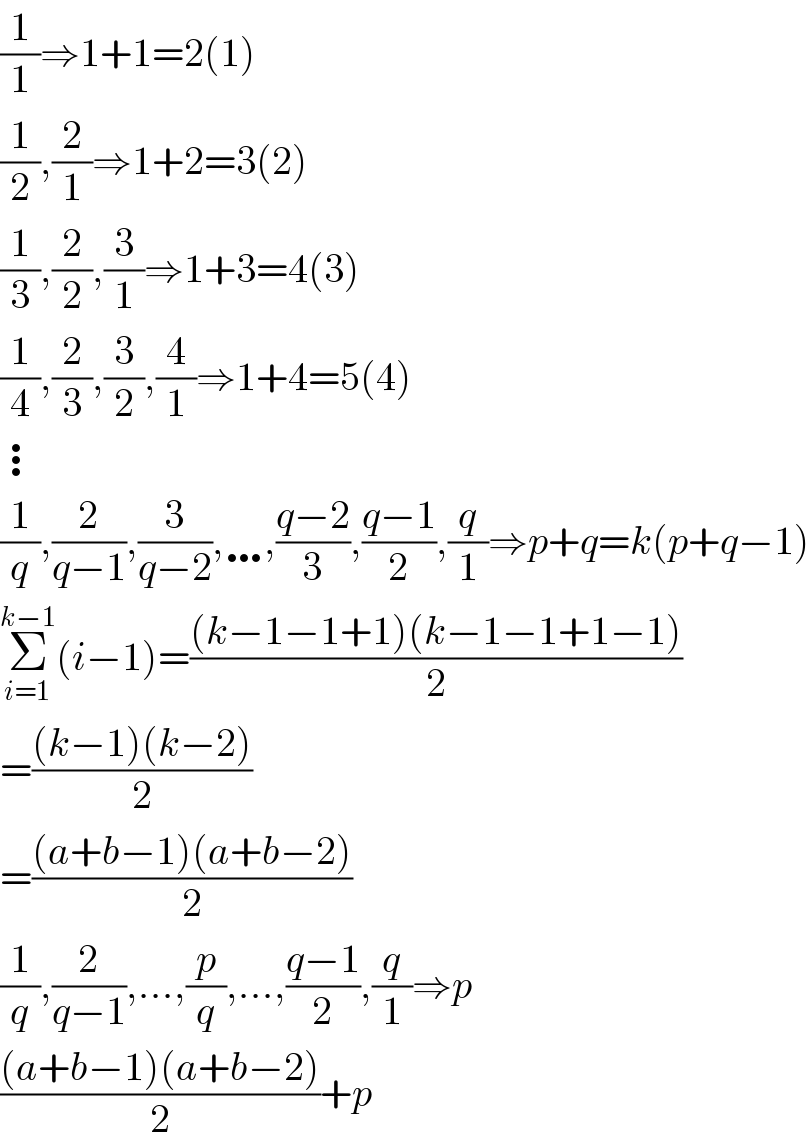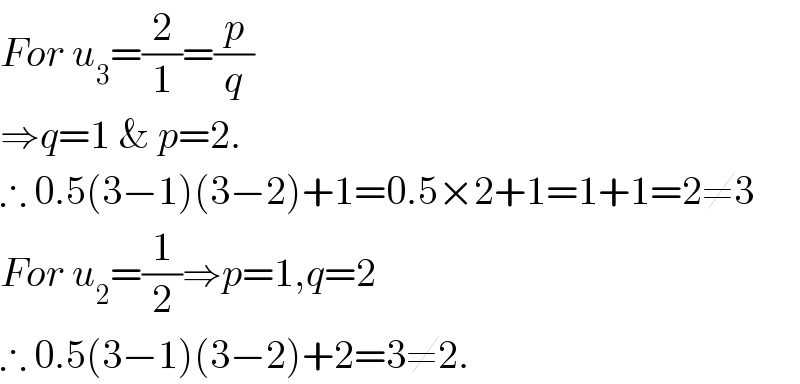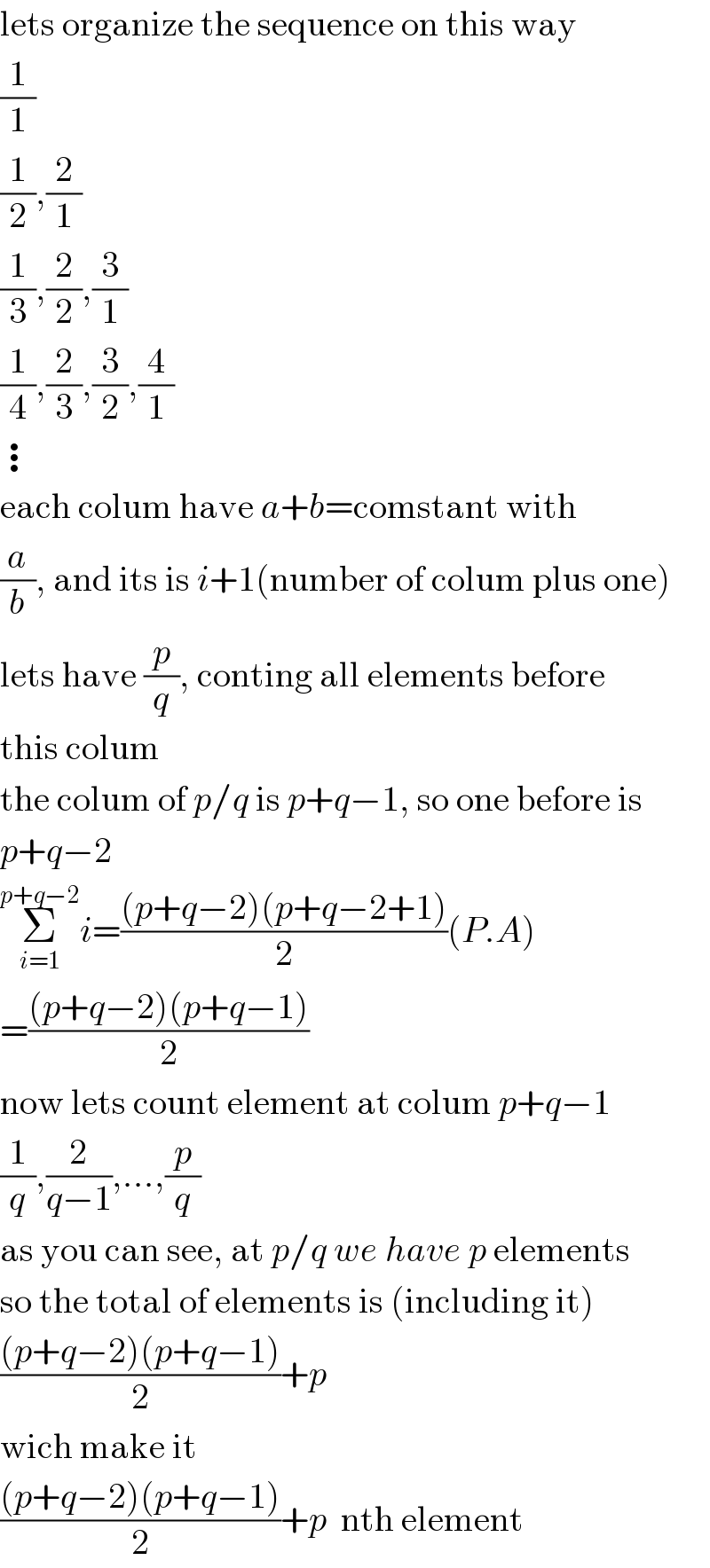
Question Number 5125 by Rojaye Shegz last updated on 16/Apr/16

Commented by Rojaye Shegz last updated on 16/Apr/16

$$\mathrm{Sorry},\:\mathrm{that}\:\mathrm{was}\:\mathrm{an}\:\mathrm{error}. \\ $$$$\frac{\mathrm{p}}{\mathrm{q}}\:\mathrm{is}\:\mathrm{the}\:\left\{\frac{\mathrm{1}}{\mathrm{2}}\left(\mathrm{p}+\mathrm{q}−\mathrm{1}\right)\left(\mathrm{p}+\mathrm{q}−\mathrm{2}\right)+\mathrm{p}\right\}\mathrm{th}\:\mathrm{term} \\ $$
Commented by 123456 last updated on 17/Apr/16

$$\frac{\mathrm{1}}{\mathrm{1}}\Rightarrow\mathrm{1}+\mathrm{1}=\mathrm{2}\left(\mathrm{1}\right) \\ $$$$\frac{\mathrm{1}}{\mathrm{2}},\frac{\mathrm{2}}{\mathrm{1}}\Rightarrow\mathrm{1}+\mathrm{2}=\mathrm{3}\left(\mathrm{2}\right) \\ $$$$\frac{\mathrm{1}}{\mathrm{3}},\frac{\mathrm{2}}{\mathrm{2}},\frac{\mathrm{3}}{\mathrm{1}}\Rightarrow\mathrm{1}+\mathrm{3}=\mathrm{4}\left(\mathrm{3}\right) \\ $$$$\frac{\mathrm{1}}{\mathrm{4}},\frac{\mathrm{2}}{\mathrm{3}},\frac{\mathrm{3}}{\mathrm{2}},\frac{\mathrm{4}}{\mathrm{1}}\Rightarrow\mathrm{1}+\mathrm{4}=\mathrm{5}\left(\mathrm{4}\right) \\ $$$$\vdots \\ $$$$\frac{\mathrm{1}}{{q}},\frac{\mathrm{2}}{{q}−\mathrm{1}},\frac{\mathrm{3}}{{q}−\mathrm{2}},\ldots,\frac{{q}−\mathrm{2}}{\mathrm{3}},\frac{{q}−\mathrm{1}}{\mathrm{2}},\frac{{q}}{\mathrm{1}}\Rightarrow{p}+{q}={k}\left({p}+{q}−\mathrm{1}\right) \\ $$$$\underset{{i}=\mathrm{1}} {\overset{{k}−\mathrm{1}} {\sum}}\left({i}−\mathrm{1}\right)=\frac{\left({k}−\mathrm{1}−\mathrm{1}+\mathrm{1}\right)\left({k}−\mathrm{1}−\mathrm{1}+\mathrm{1}−\mathrm{1}\right)}{\mathrm{2}} \\ $$$$=\frac{\left({k}−\mathrm{1}\right)\left({k}−\mathrm{2}\right)}{\mathrm{2}} \\ $$$$=\frac{\left({a}+{b}−\mathrm{1}\right)\left({a}+{b}−\mathrm{2}\right)}{\mathrm{2}} \\ $$$$\frac{\mathrm{1}}{{q}},\frac{\mathrm{2}}{{q}−\mathrm{1}},...,\frac{{p}}{{q}},...,\frac{{q}−\mathrm{1}}{\mathrm{2}},\frac{{q}}{\mathrm{1}}\Rightarrow{p} \\ $$$$\frac{\left({a}+{b}−\mathrm{1}\right)\left({a}+{b}−\mathrm{2}\right)}{\mathrm{2}}+{p} \\ $$
Commented by Rojaye Shegz last updated on 17/Apr/16

$$\mathrm{I}\:\mathrm{dont}\:\mathrm{understand}\:\mathrm{your}\:\mathrm{solution} \\ $$$$\mathrm{but}\:\mathrm{im}\:\mathrm{gaining}\:\mathrm{insight}\:\mathrm{on}\:\mathrm{how}\:\mathrm{it}\:\mathrm{should} \\ $$$$\mathrm{be}\:\mathrm{solved}.\:\mathrm{Please}\:\mathrm{explain} \\ $$$$\mathrm{Thanks}^{+} \\ $$
Answered by Yozzii last updated on 16/Apr/16

$${For}\:{u}_{\mathrm{3}} =\frac{\mathrm{2}}{\mathrm{1}}=\frac{{p}}{{q}} \\ $$$$\Rightarrow{q}=\mathrm{1}\:\&\:{p}=\mathrm{2}. \\ $$$$\therefore\:\mathrm{0}.\mathrm{5}\left(\mathrm{3}−\mathrm{1}\right)\left(\mathrm{3}−\mathrm{2}\right)+\mathrm{1}=\mathrm{0}.\mathrm{5}×\mathrm{2}+\mathrm{1}=\mathrm{1}+\mathrm{1}=\mathrm{2}\neq\mathrm{3} \\ $$$${For}\:{u}_{\mathrm{2}} =\frac{\mathrm{1}}{\mathrm{2}}\Rightarrow{p}=\mathrm{1},{q}=\mathrm{2} \\ $$$$\therefore\:\mathrm{0}.\mathrm{5}\left(\mathrm{3}−\mathrm{1}\right)\left(\mathrm{3}−\mathrm{2}\right)+\mathrm{2}=\mathrm{3}\neq\mathrm{2}. \\ $$
Answered by 123456 last updated on 17/Apr/16

$$\mathrm{lets}\:\mathrm{organize}\:\mathrm{the}\:\mathrm{sequence}\:\mathrm{on}\:\mathrm{this}\:\mathrm{way} \\ $$$$\frac{\mathrm{1}}{\mathrm{1}} \\ $$$$\frac{\mathrm{1}}{\mathrm{2}},\frac{\mathrm{2}}{\mathrm{1}} \\ $$$$\frac{\mathrm{1}}{\mathrm{3}},\frac{\mathrm{2}}{\mathrm{2}},\frac{\mathrm{3}}{\mathrm{1}} \\ $$$$\frac{\mathrm{1}}{\mathrm{4}},\frac{\mathrm{2}}{\mathrm{3}},\frac{\mathrm{3}}{\mathrm{2}},\frac{\mathrm{4}}{\mathrm{1}} \\ $$$$\vdots \\ $$$$\mathrm{each}\:\mathrm{colum}\:\mathrm{have}\:{a}+{b}=\mathrm{comstant}\:\mathrm{with} \\ $$$$\frac{{a}}{{b}},\:\mathrm{and}\:\mathrm{its}\:\mathrm{is}\:{i}+\mathrm{1}\left(\mathrm{number}\:\mathrm{of}\:\mathrm{colum}\:\mathrm{plus}\:\mathrm{one}\right) \\ $$$$\mathrm{lets}\:\mathrm{have}\:\frac{{p}}{{q}},\:\mathrm{conting}\:\mathrm{all}\:\mathrm{elements}\:\mathrm{before} \\ $$$$\mathrm{this}\:\mathrm{colum} \\ $$$$\mathrm{the}\:\mathrm{colum}\:\mathrm{of}\:{p}/{q}\:\mathrm{is}\:{p}+{q}−\mathrm{1},\:\mathrm{so}\:\mathrm{one}\:\mathrm{before}\:\mathrm{is} \\ $$$${p}+{q}−\mathrm{2} \\ $$$$\underset{{i}=\mathrm{1}} {\overset{{p}+{q}−\mathrm{2}} {\sum}}{i}=\frac{\left({p}+{q}−\mathrm{2}\right)\left({p}+{q}−\mathrm{2}+\mathrm{1}\right)}{\mathrm{2}}\left({P}.{A}\right) \\ $$$$=\frac{\left({p}+{q}−\mathrm{2}\right)\left({p}+{q}−\mathrm{1}\right)}{\mathrm{2}} \\ $$$$\mathrm{now}\:\mathrm{lets}\:\mathrm{count}\:\mathrm{element}\:\mathrm{at}\:\mathrm{colum}\:{p}+{q}−\mathrm{1} \\ $$$$\frac{\mathrm{1}}{{q}},\frac{\mathrm{2}}{{q}−\mathrm{1}},...,\frac{{p}}{{q}} \\ $$$$\mathrm{as}\:\mathrm{you}\:\mathrm{can}\:\mathrm{see},\:\mathrm{at}\:{p}/{q}\:{we}\:{have}\:{p}\:\mathrm{elements} \\ $$$$\mathrm{so}\:\mathrm{the}\:\mathrm{total}\:\mathrm{of}\:\mathrm{elements}\:\mathrm{is}\:\left(\mathrm{including}\:\mathrm{it}\right) \\ $$$$\frac{\left({p}+{q}−\mathrm{2}\right)\left({p}+{q}−\mathrm{1}\right)}{\mathrm{2}}+{p} \\ $$$$\mathrm{wich}\:\mathrm{make}\:\mathrm{it} \\ $$$$\frac{\left({p}+{q}−\mathrm{2}\right)\left({p}+{q}−\mathrm{1}\right)}{\mathrm{2}}+{p}\:\:\mathrm{nth}\:\mathrm{element} \\ $$
